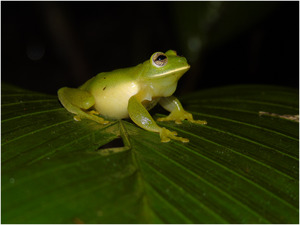Magdalena giant glass frog facts for kids
Quick facts for kids Magdalena giant glass frog |
|
|---|---|
 |
|
| Adult male | |
| Conservation status | |
| Scientific classification | |
| Synonyms | |
|
The Ikakogi tayrona, also known as the Magdalena giant glass frog, is a special type of frog that belongs to the Centrolenidae family. It's called a "glass frog" because some species have skin so clear you can see their insides! This particular frog lives only in the Sierra Nevada de Santa Marta mountains in Colombia. What makes it really unique is that it's the only known glass frog where the mother frog takes care of the eggs. Usually, if any parent cares for the eggs in other glass frog species, it's the father.
Contents
What Does It Look Like?
Male Ikakogi tayrona frogs are about 28.2 to 30.6 millimeters long from snout to vent (their bottom). Females are very similar in size, measuring 28.2 to 30.8 millimeters.
Their head is quite large and wide. When you look at it from above, their snout (nose area) looks rounded. But if you look from the side, it appears sloped and cut off.
These frogs are green to pale green in color. Their skin on the back feels a bit bumpy or grainy. Male frogs have a noticeable humeral spine, which is a small, sharp bone on their upper arm.
Reproduction and Life Cycle
Ikakogi tayrona frogs breed on plants that grow next to streams. Male frogs will call out from the same or nearby leaves night after night. Sometimes, males might even fight each other over a good spot.
The female frog lays her eggs on the same leaves where the males have been calling. These egg clutches are usually about 0.5 to 2 meters (about 1.5 to 6.5 feet) above the ground. It's possible they lay eggs even higher, but those spots are harder to see.
What's really special is that only the female frogs have been seen guarding the eggs. She stays with the eggs almost all night long. During the day, she might leave the clutch for a short time. Scientists found that if the mother frog was removed, many more eggs died. This shows how important her care is!
Where It Lives and How We Protect It
The Ikakogi tayrona frog lives in natural habitats like sub-Andean forests and cloud forests. You can find them on plants close to water sources. They live at elevations ranging from 700 to 2400 meters (about 2,300 to 7,900 feet) above sea level.
A part of their home is protected within the Sierra Nevada de Santa Marta National Natural Park. They also live in the El Dorado Nature Reserve, which is protected by Fundación ProAves.
However, outside these protected areas, the frogs face threats. Their homes are being lost because of habitat loss. Also, pollution in the water and the spraying of crops with chemicals are dangers to these unique frogs.
See also
 In Spanish: Ikakogi tayrona para niños
In Spanish: Ikakogi tayrona para niños
- Ikakogi ispacue


